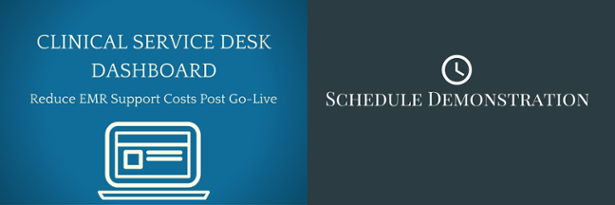Epic Service Desk: Why Should An Organization Invest? (Video)

In this post, Michael Sinno – Chief Operating Officer – discusses 3 key reasons why an organization should invest in an Epic Service Desk.
Transcript:
An Epic investment is a substantial one—one that rivals that of brick and mortars in some instances. So, in order to maximize that investment in your EHR, you don’t want to reduce it to the least common denominator, which could be a help desk or a service desk. No matter how effective they are, they have multiple applications that need to be supported outside of Epic. And, when I say “multiple,” it’s in the hundreds. So, the expectation for them to be well versed in Epic, as well as the other applications, is an unrealistic one. What often happens is an inefficient process where they operate in a catch and dispatch manner. What I mean by that is, the clinician or their support staff calls in, they articulate their issue to the service desk, and the service desk simply captures the information and may or may not appropriately triage that back to tier two.
1. Efficiency
So, the number one issue is efficiency, right? In a clinical service desk or an Epic service desk, you’re able to collect the information, remediate it at that level, and if not, appropriately triage it to the right support group on the back end.
2. Cost
The number two issue is cost. While an Epic service desk certainly will require a level of investment, it’ll pay itself back in twofold. So one, you are no longer placing that burden on your tier two analysts who are hired out as resources. They’re getting the information in from that clinical service desk or the Epic service desk, and it’s immediately actionable because they’re collecting the right information up front. Likewise, you’re not placing that burden back on the person who’s calling in with the information that a normal service desk would have gotten, and then has a tier two analyst calling them back to get additional information. It’s one time, because the Epic service desk will be skilled to do that.
3. Clinician & Physician Adoption Satisfaction
And the number three issue, just for general clinician/physician adoption satisfaction, nothing’s more frustrating after they’ve gone live than to call into the help desk and not get that level of instant gratification to answer their question. That’s only tolerated for so long. Then what happens is, as that information comes back to tier two analysts, the backlog starts to begin, confidence starts to get shaken that the support model is broken, and it takes too long to get issues resolved. Being able to call in to somebody that’s familiar with your environment, familiar with your workflows, is able to speak the same language and ideally help you before get off the phone, will promote itself for end user adoption satisfaction.
You may also be interested in:
- Go-Live "Best" Practices to Avoid
- Epic Service Desk – Why Analytics Hold The Key
- Beyond the Clinical Service Desk: Sustaining Your EHR in Austerity
- eBook: The Definitive EHR Go-Live Guide
Michael has 23 years of information technology and 13 years of healthcare experience as a healthcare IT Executive. He is responsible for the management of HCI solutions and oversight of operations and delivery. Michael has successfully led implementations and the subsequent support of both large scale Epic and Cerner Electronic Health Records in the capacity of CIO within two Academic Medical Centers. Also a former CTO, he is technologically fluent and operationally disciplined, providing leadership and efficiency in organizations that view technology as a business catalyst and force multiplier.

